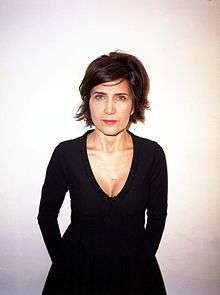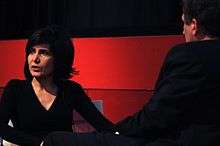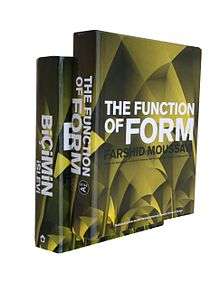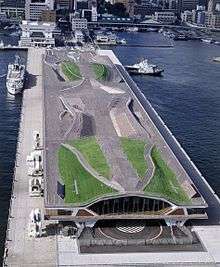Farshid Moussavi
| Farshid Moussavi | |
|---|---|
 | |
| Born |
1965 Shiraz, Iran (from Mazandaran, Sari) |
| Nationality | British |
| Alma mater |
Harvard University Bartlett School of Architecture, University College London Dundee University |
| Occupation | Architect |
| Practice |
Farshid Moussavi Architecture Previously Foreign Office Architects |
| Buildings |
Ōsanbashi, International Passenger Terminal, Yokohama, Kanagawa, Japan John Lewis complex, Leicester, UK Museum of Contemporary Art, Cleveland, Ohio Victoria Beckham Flagship Store, London, UK |
| Projects |
The Function of Ornament The Function of Form The Function of Style |
| Website | Official website |
Farshid Moussavi OBE RA RIBA is an Iranian-born British architect, founder of Farshid Moussavi Architecture (FMA) and Professor in Practice of Architecture at Harvard University Graduate School of Design. She was co-founder and co-principal of Foreign Office Architects (FOA) until June 2011.
Early career
Moussavi was born in Iran and immigrated to London in 1979. She trained in architecture at the Dundee School of Architecture, University of Dundee, The Bartlett School of Architecture, University College London and graduated with a Masters in Architecture (MArch II) from the Harvard University Graduate School of Design, Harvard University. Moussavi first came to prominence with FOA, the practice she co-founded in 1995. Previously, she had worked at the Renzo Piano Building Workshop and the Office of Metropolitan Architecture (OMA) before moving back to London to teach at the Architectural Association and start her own practice, Foreign Office Architects (FOA). At FOA, Moussavi co-authored the design for the award-winning Yokohama International Ferry Terminal in Japan (which was subject to an international design competition in 1995) and was part of the United Architects team who were finalists in the Ground Zero competition. She also completed a wide range of international projects including the John Lewis complex in Leicester, England and the Meydan retail complex in Istanbul, Turkey.
Later career
In June 2011, Moussavi announced the opening of her new practice, Farshid Moussavi Architecture (FMA), based in London. In October 2012, FMA's first museum and first building in America, the Museum of Contemporary Art Cleveland, opened to the public. In August 2012, its installation titled 'Architecture and Affects' featured at the 13th edition of Venice Architecture Biennale in Italy. FMA has also designed Victoria Beckham's flagship store in London, which opened in September 2014. The practice is currently working on a number of projects internationally including residential complexes in Montpellier and La Défense district of Paris, France, as well as an office tower in London, UK. The practice was a finalist for the Museum and Educational Centre of the Polytechnic Museum and Lomonosov Moscow State University competition and joint winner of the international competition for the new headquarters of the International Olympic Committee (IOC) in Lausanne.
Moussavi has served on numerous design committees including the Mayor of London's Design for London Advisory Group and LDA International Design Committee, the RIBA Gold and Presidents Medals, the Stirling Prize and the Venice Architecture Biennale. She was Chair of the Master Jury of the Aga Khan Award for Architecture in 2004, and a member of the Award's Steering Committee between 2005-2015. She was an external examiner for the Royal College of Art in London from 2010-2013 and for the Sir John Cass Faculty of Art, Architecture and Design from 2014-2016, and a columnist for the Architectural Review. She is currently an external examiner for The Architectural Association in London and serves on the academic court of The London School of Architecture. She is also a trustee of the Whitechapel Gallery as well as the Architecture Foundation in London, a role she has maintained since 2009.
Research

Alongside her professional practice, Moussavi has held a longstanding commitment to research across the academic and professional field of architecture. Since 2005, she has been Professor in Practice at Harvard University Graduate School of Design. Previously, Moussavi taught at the Architectural Association in London for eight years (1993–2000), and was subsequently appointed as Head of the Academy of Fine Arts in Vienna (2002–2005). She has been a visiting professor of architecture at the Berlage Institute in Rotterdam, the Hoger Architectuur Instituut Sint-Lucas in Gent, and in the USA, at UCLA, Columbia University and Princeton University.
Moussavi's research, which began while teaching at the Architectural Association in the early 90s, has focused on instruments that allow architects to embed built forms with design intelligence and creative possibilities – such as the diagram, information technology, new construction technologies, envelopes and tessellation – and how they can be used to develop alternative concepts for the practice of architecture.

Since 2004, Moussavi's research has focused predominantly on the relationship between the construction and experience of a built form, and how the architect’s agency is to navigate the many choices provided by the design process to give built forms the unique propensities which individuals experience as affect. Her work in aesthetics is influenced by a range of philosophers, notably Spinoza, Gilles Deleuze and Félix Guattari, and Jacques Rancière. Following from Gilles Deleuze's work on affect, she proposes that built forms' affects play an active role in the daily experiences of individuals and the affections they develop. Moussavi argues that, in order to move people’s experience away from routine and to open up the possibility for new types of action, architects need to provide built forms with novel affects. It is not what built forms represent but how they provide experiences that would otherwise not exist that makes their aesthetic experience relevant and gives their architecture a function or agency in culture.
Moussavi has published three books: The Function of Ornament, The Function of Form and The Function of Style in conjunction with her teaching at Harvard, all of which disclaim architecture’s traditional binary oppositions – form vs.function, structure vs. form, ornament vs. function, style vs. function – proposing that architecture’s creative potential lies, rather, in finding ways to relate them to one other.
The Function of Ornament

In The Function of Ornament (2006), Moussavi proposes that ornament has always carried a function, and that function is the construction of aesthetic experience. In this book, she argues that contemporary ornament is not symbolic and does not function through the representation of something else but through its own actuality. She proposes that in order for built forms to contribute to how culture evolves, ornament should not conceived through a set of superficial and decorative elements which are introduced to a building to be representational or symbolic of external narratives, but should be constructed through the elements that define an actual built form so that the actuality of it defines a new and inherent aesthetic contributions. Ornament is that which makes the actuality of one form distinct from another, a distinction which is the result of the architect's activity, rather than something imported from an 'external' realm.
Redefined as such, ornament is integral to each built form and can engage a variety of depths depending on the way the architect assembles the form's particular set of concerns or materials. Ornament may therefore be experienced through the entire form of a building, the depth of its external envelope or the surface of its external envelope, as a cluster of affects.
Rather than functioning through symbol and meaning, this definition of ornament positions the function of ornament through a built form’s affects and therefore their actual aesthetic experience. Unlike symbolic definitions of ornament, which are rooted in a unified concept of society, Moussavi's definition of ornament argues that in a contemporary plural society – which lacks shared image-memories – the non-representational nature of affects allows built forms to be perceived by everyone but differently, making allowance for different subjectivities. This enables the built environment, like movies, music and art, to act as a common social fabric.
The Function of Form

In The Function of Form (2009), Moussavi further explores the relationship between the construction of an architectural built form and its aesthetic experience away from the limitations of representation (symbolism), towards repetition and differentiation to nurture multiplicity within culture.
Fundamental to Moussavi's proposal is that, due to the speed at which technology, the environment and culture are changing, the rate of change in contemporary architecture has shifted from a process of overhaul and replacement to a mode of continuous and incremental change. This rapid rate of change is the consequence of multiple intersecting causes which are rooted in human (social, subjective, sensorial) as well as nonhuman (natural, objective, technical) spheres. In order to be compatible with these mutating and diverse values, architecture cannot be limited to the representation of a-priori concepts or singular causes and must evolve through constantly producing, enriching and reinventing its environment.
Moussavi revisits the relationship between function and form and proposes that – rather than being considered as the outcome of movements – the history of form contains a continuous thread in which historical ideas have been evolved and transformed to produce novel forms. To illustrate this, The Function of Form presents built forms with distinctive structural systems from 500 to the present and classifies them into seven groups (Grids and Frames, Vaults, Domes, Folded Plates, Shells, Tensile Membranes, Pneumatic Membranes).
To illustrate this, The Function of Form presents a survey of experiments with the repetition and differentiation of structural systems, dating back to 12th century such as those with 12th-century vaults, 15th-century domes, or 20th-century frames, and pneumatic and tensile structures, each time generating a novel built form. The Function of Form detaches each building from its original motives, author or context, and presents them side by side each other as a comparative rather than symptomatic study. Particularised and differentiated in this way, these physical structures become mutable and can be re-appropriated and transformed without prejudice, to produce novel built forms with singular affects which individuals with different norms, desires and habits can cohabit.
The Function of Style

The third volume in Moussavi's Function series, The Function of Style (2015) interrogates what the function of style is today. If the 1970s were defined by Postmodernism and the 1980s by Deconstruction, how do we characterize the architecture of the 1990s to the present? Some built forms transmit affects of curvilinearity, others of crystallinity; some transmit multiplicity, others unity; some transmit cellularity, others openness; some transmit dematerialization, others weight. Does this immense diversity reflect a lack of common purpose?
Moussavi argues that the diversity of contemporary architecture should not be mistaken for an eclecticism driven by external forces and is the outcome of a new approach to style which is driven not by representation but by aesthetic experience. She defines contemporary style as the agency given to the elements of a building through their specific arrangement, which manifests itself as a cluster of affects that spreads out from the building and influences the kind of assemblage people will form with it as they take part in their everyday activities like residing or working. Moussavi also proposes that architects, by shifting the conventions associated with a building for certain activity, can generate a new presence or style for it that loosens the building’s traditional relationship with that activity and allows people the freedom to creatively respond to it.
The Function of Style suggests that this new way of understanding style reveals a coherence underlying the diversity in contemporary architecture. The book presents compares buildings from two timeframes, the early 20th century and the period from 1990 to the present, and highlights similarities in the way they are organised in relation to the activities (like working, residing or shopping) which they host. Identifying the similarities between past and more recent buildings makes apparent, as in an open source, architecture provides ideas which can be shared between architects, not for copying but for creating something new. This involves appropriating conventions of arrangement established by other projects, questioning them, and shifting them to make something new appear in the encounter between people and their everyday activities. Moussavi argues that by embracing the process of making choices regarding the assembly of buildings for everyday life as a raw material, architects assume the agency or freedom to change the conventions of how buildings are assembled, to ground style, and people’s aesthetic experience of buildings, in the micropolitics of the everyday.
Selected projects
Farshid Moussavi Architecture
- Victoria Beckham Store, Hong Kong, China (2016)
- Victoria Beckham Flagship Store, London, UK (2014)
- 130 Fenchurch Street Office Complex, London, UK (2013-)
- Les Jardins de la Lironde Residential Complex, Montpellier, France (2013-)
- Museum of Contemporary Art, Cleveland, Ohio (2012)
- La Défense Residential Complex, Paris (2011-)
- Installation for Common Ground at 13th Architecture Biennale in Venice (2012)
Foreign Office Architects
- Osanbashi Yokohama International Passenger Terminal, Japan (1995–2002)
- Bluemoon Hotel, Groningen, the Netherlands (1999–2000)
- Police headquarters, La Villajoyosa (2000-3)
- Coastal park with outdoor auditoriums, Barcelona (2000-4)
- Headquarters for Dulnyouk Publishers, Paju (2000-5)
- Municipal Theatre, Torrevieja (2000-6)
- John Lewis department store and Cineplex and pedestrian bridges, Leicester (2000-8)
- British Pavilion at the International Architectural Biennial, Venice (2002)
- Olympics 2012 & Lower Lea Valley Regeneration Masterplan, London (2003)
- La Rioja Technology Transfer Centre, Logrono (2003-7)
- Trinity EC3 office complex, City of London (2003-)
- Spanish Pavilion at the 2005 International Expo, Aichi (2004-5)
- Social housing in Carabanchel, Madrid (2004-7)
- Villa in Pedralbes, Barcelona (2004-8)
- D-38 Office Complex, Barcelona (2004–10)
- Meydan Retail Complex and Multiplex, Istanbul (2005-7)
- Ravensbourne college on the Greenwich Peninsula, London (2005–10)
- World Business Centre, Busan (2006-)
- KL Central Plot D Residential Towers, Kuala Lumpur (2006-)
- Sevenstone Quarter mixed-use complex, Sheffield (2007-)
- Euston Station, London (2008-)
- Mixed-use extension of West Quay II retail centre, Southampton (2008-)
- New Street Station, Birmingham (2008 -)
Selected awards

- Enric Miralles Prize for Architecture (2003)
- Kanagawa Prize for Architecture in Japan (2003)
- RIBA International Award (2004)
- Lion Award for Topography at the 9th Venice Architecture Biennale (2004)
- Charles Jencks Award for Architecture (2005)
- RIBA International Award (2005)
- RIBA International Award (2006)
- RIBA European Award (2008)
- European Business Award for the Environment (2008)
- Urban Land Institute Award for Excellence (2008)
- RIBA Award (2009)
- Civic Trust Award (2010)
- International Council of Shopping Centres Award (2010)
- International Architecture Award (2010)
- RIBA Award for Ravensbourne (2011)
Books and articles
Books
- The Function of Ornament (2006)
- The Function of Form (2009)
- The Function of Style (2015)
Articles
- "11 Women Shaping Our Skylines" in iD's 'Amuse', March 2016, UK
- Interview in Something Curated, July 2016, UK
- "The 'unpredictable' architect behind Victoria Beckham's flagship store" in WIRED, September 2016, UK
- "In The Studio with Farshid Moussavi RA" in RA Magazine, Winter 2016 issue, UK
- "My Genius: Farshid Moussavi" in PORT, November 2016, UK
- "Style and Substance: Interview with Farshid Moussavi" in The Architectural Review, June 2014 issue, UK
- "Planning is an art form" in The Architectural Review, Dec 2013 issue, UK
- "Creative leaps in the arena of architectural competitions" in The Architectural Review, January 2013 issue, UK
- "30 St Mary Axe" in Harvard Design Magazine 2012, number 35
- "An Archaeological Approach" in Instigations: Engaging Architecture, Landscape, and the City (2012)
- “School buildings produce culture” in The Architectural Review, September 2012 issue, UK
- “Agenda bender: the case for the abolition of female role models” in The Architectural Review, May 2012 issue, UK
- “Architecture and activism should be as closely linked as the problems we need to solve” in The Architectural Review, December 2011 issue, UK
- "Parametric software is no substitute for parametric thinking" in The Architectural Review, September 2011 issue, UK
References
- The Function of Style lecture at Harvard GSD, 2015
- Style Agency lecture at Harvard GSD, 2012
- New Models of Research lecture at Harvard GSD, 2015
- Phylogenesis: foa’s ark, Actar, Barcelona, Spain, 2003
- Foreign Office Architects, El Croquis, # 115/116, Madrid, Spain, 2003
- The Yokohama Project, Actar, Barcelona, Spain, 2002
- Foreign Office Architects, 2G # 16: A monograph on the designers of the Yokohama Port Terminal and other interesting projects], (English/Spanish) Gustavo Gili, Barcelona, Spain, 2001
- Article on FMA's Museum of Contemporary Art in Wallpaper Magazine
- L’Architecture D’Aujourd'hui Special Issue on Farshid Moussavi
- Article on Farshid Moussavi in W magazine
- FMA's Museum of Contemporary Art in Cleveland in Architectural Review
- MOCA in The Plan
- MOCA reviewed in Can Journal, Cleveland
- MOCA and other recent museums reviewed in the Wall Street Journal
- Ciro Najle interviews Farshid Moussavi in The Plot
- New York Times article on FMA's installation at the 2012 Venice Architecture Biennale
- Farshid Moussavi Book List
- Farshid Moussavi at IACC Lecture Series 2010/2011
- Farshid Moussavi lecture at the Pavillon de l'Arsenal, 12 November 2007
- Farshid Moussavi in conversation with Nader Tehrani
- Function of Form (Turkish)
- Woodman, Ellis (3 May 2008), "Foreign Office Architects: No, it's not a Guggenheim - it's a John Lewis"
- Farshid Moussavi RA Elect
External links
| Wikimedia Commons has media related to Farshid Moussavi. |
